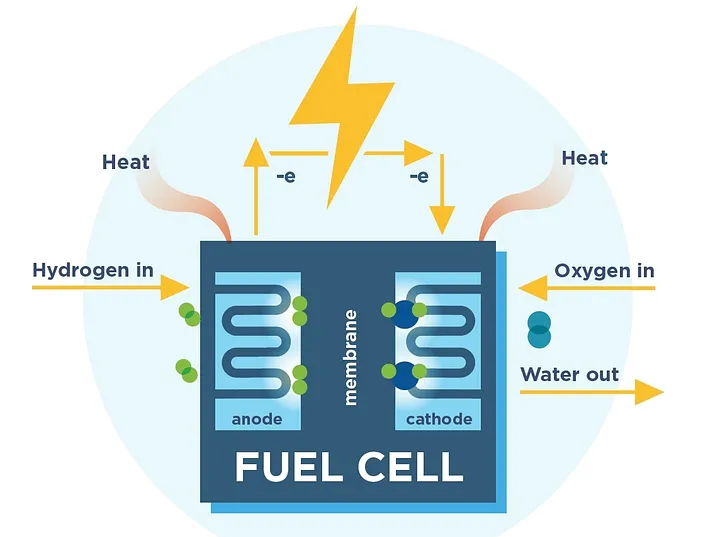Author: Kiersten Sundell

What is hydrogen fuel technology, and how does it relate to nuclear?
Let’s start with hydrogen gas. It doesn’t exist naturally in an accessible form, so engineers extract it in one of two ways. The first is called methane steam reforming, which is a carbon-intensive chemical process currently used to produce 90% of global hydrogen. The other method is to separate the hydrogen and oxygen molecules in water in a process called electrolysis. The resulting hydrogen can be used to produce energy when used in a fuel cell — a big box where a carefully engineered chemical reaction takes place.
Grid-scale fuel cells are around the size of a large shipping container or an 18-wheeler truck, and they use an electrochemical reaction to convert chemical energy into electrical energy. If you’re interested in the chemistry of it all, the reaction essentially feeds the hydrogen atoms through a negatively charged anode, into an electrolyte solution that rips apart the protons and electrons, and then into a positively charged cathode. This process creates electricity, and the only byproduct is water. It sounds too good to be true — why aren’t we making ALL of our energy with hydrogen?
Well, it requires a good amount of energy — at the moment, about 53 kWh of electricity to produce one kg of hydrogen. This one kg of hydrogen holds the potential to produce 39.4 kWh of electrical energy, clearly resulting in a net loss of electricity.
But what if we have excess electricity to begin with?
What I mean by this is that when the demand for electricity on the grid is lower than the amount of electricity produced, power companies will lose money. They have too much electricity and nobody wants to pay for it. This happens a lot with solar power — it produces a ton of energy during the day, but significantly less in the evening when the demand is highest. Same thing with wind, but seasonally. It’s windiest in the spring and fall when we don’t need as much power for heaters or air conditioning.
If this energy is not used right when it is produced, it is either thrown away, stored in expensive batteries, or can be used to produce hydrogen. In this case, the hydrogen could be stored until the demand for electricity rises again, at which point we could feed it through a fuel cell.
Now there are a few reasons why there isn’t a hydrogen fuel cell retrofitted onto every power plant in the country. One is that the technology is expensive. It’s hard to tell how long it will take for the money you make selling hydrogen energy to exceed the price of building the fuel cell.
Another reason is that just storing the hydrogen takes a lot of energy, never mind all of the conversion processes it takes to make it in the first place. Hydrogen requires extremely high pressures and very low temperatures since it’s a gas made of the smallest atoms that exist. To get around these requirements we could add some nitrogen and convert it into ammonia which can be stored under more normal conditions, but this is just another added step in the million-step conversion process — and guess what — requires more energy.
Head to our TikTok page to watch the full video and tell us your thoughts on hydrogen!


